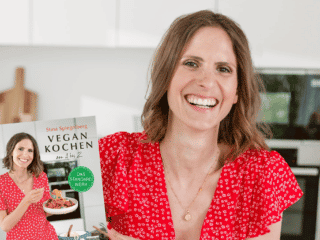Rice protein – facts about the underestimated vegan protein source
- Posted on
- 6 minute read
- Christin Uthoff

Protein powders are widely used, especially among people who are active in sports. Often used on Soy protein or classic Whey Protein. Another and so far less known alternative is rice protein . It is suitable as part of a vegan diet and is also a good choice if you have a soy allergy. It is also lactose and gluten free.
With this article we provide you with all the important information about rice and rice protein powder and reveal for which people this protein source can be useful.
Rice protein - facts about the underestimated vegan protein source
What is rice protein?
Rice naturally contains proteins. In its raw state, rice has a protein content of slightly more than 7 g protein per 100 g. Rice protein is obtained from whole grain rice by isolating it from the germinated rice grains in a complex fermentation process . This results in a high-quality vegetable protein powder that is available as a supplement. It is 100% vegan, lactose-free and gluten-free. It is also soy-free, making it a good source of protein for people with allergies.
Rice protein powder ingredients
Rice protein powder contains about 80 g of high-quality vegetable protein per 100 g, depending on the manufacturer. It also scores with 3 to 5 g of dietary fiber per 100 g . In addition, it provides carbohydrates, fats, vitamins and minerals that are also contained in the whole rice grain. With regard to vitamins and minerals, it is not possible to make a clear statement about the amount contained, as this varies from manufacturer to manufacturer and is often not listed in the nutritional value table on the product page.
Additives and organic rice protein
When buying, make sure that no artificial flavors, preservatives or sugar have been added if you want to use a natural product. The naturalness testifies to high quality. Organic rice protein can also be a good choice, as it often contains no or only a small amount of additional ingredients. In addition, organic products contain fewer pesticides.
Whole grain rice vs. white rice
The rice grain from which rice protein is isolated consists of endosperm, seed coat, fruit coat and germ. Seed coat and fruit coat are also known as the silverskin . The endosperm consists largely of carbohydrates. Silverskin and sprout provide minerals, proteins, healthy fats and vitamins.

White rice is polished so that mainly the endosperm, i.e. the carbohydrates, remain. It has a longer shelf life due to the absence of silverskin and seedling, but is also lower in nutrients.
At whole grain rice also known as brown rice, the whole rice grain is processed – including the nutrient-rich components. It has a longer cooking time and less shelf life. However, it convinces with the valuable ingredients from silverskin and germ. Rice protein powder is therefore made from whole grain rice.
Biological value
Rice protein powder, as already mentioned, has a relatively high protein content of about 80g per 100g. It provides all essential amino acids, although not in optimal relation to each other. Cereals contain only small amounts of the essential amino acid lysine – so does rice. To increase the biological value, that is, the efficiency with which the body can use the proteins, the combination with legumes is ideal. Rice protein powder is therefore often available in combination with pea protein. Peas provide more lysine than rice, so the amino acids complement each other perfectly. The amino acid profile thus corresponds almost perfectly to the needs of the human body.
Also interesting:
You can read more about plant-based protein sources and vegan sports nutrition here.
Advantages of rice protein
- Rice protein can help meet the daily requirement of vitamins and minerals.
- The fiber it contains can promote intestinal health. A healthy intestine supports digestion and is important for general well-being.
- As a high-quality protein supplier, rice protein can help athletes build muscle mass and regenerate muscles after exercise.
- Rice protein is easily digestible and also suitable for allergy sufferers. It is lactose, gluten and soy free and 100% vegan. Thus, it is a good alternative to the classic Whey Protein.
- It can be used in a variety of ways. In smoothies, mueslis, pancakes or in protein shakes, the protein powder can convince.
- The amino acid profile is relatively balanced and can be further enhanced by combining it with pea protein.
Arsenic content in rice products
Rice and rice products such as rice wafers, rice flakes, rice porridge and rice protein powder are suspected of containing relatively high levels of inorganic arsenic. Arsenic is classified as carcinogenic for humans. Since 2016, there have been limits in the EU that the arsenic content in food must not exceed. However, it has not yet been conclusively clarified at what quantity a health hazard exists.
A safety margin is listed for infants and young children, so the limits for children’s foods are even lower. In most cases, the arsenic content applies according to the Federal Ministry for Risk Assessment is considered to be harmless. So rice is not unhealthy. On the contrary, rice is a valuable staple food that is widely consumed around the world , and rice products can also be consumed in moderation.
For whom is rice protein suitable?
Proteins are essential for life and are involved in many processes in the human body. Most people can obtain sufficient protein from their diet. Even with a vegan diet, protein requirements can usually be met through a sensible and varied combination of foods.
However, for some groups, it may be useful to supplement the daily diet with high-quality protein powder to ensure adequate supply. These are especially people who have an increased protein requirement, such as competitive athletes and bodybuilders. For example, with a high workload of sports and therefore high energy consumption, consuming protein shakes made from rice protein can help maintain or gain weight as well as build muscle mass.
Also older people from the age of 65 have an increased protein requirement. The intake of proteins in the form of liquid food can be helpful here. If solid foods are difficult to ingest, for example, due to difficulty swallowing, smoothies can be fortified with protein powder to help maintain weight and muscle mass.
Rice protein powder is also a good alternative for people with soy allergy, celiac disease, gluten sensitivity or lactose intolerance, because rice protein is usually well tolerated.
Use and dosage
For a protein sh ake, you can simply dissolve 30 g of rice protein in 150 to 200 ml of water and shake well. Alternatively, you can use vegan plant-based drinks instead of water. Almond or rice drink, for example, are well suited.
The often somewhat sandy taste of rice protein can be reduced by stirring it into smoothies . Banana, berries and co. give an additional vitamin kick and provide a pleasant fruity taste. Smoothies are also great to prepare ahead of time so you have them on hand when you need them – just be sure to store them in a cool, dry place.
You can also enrich puddings, mueslis, yogurt or pancakes with rice protein. In baking, rice protein can also be used as a vegan egg substitute. Baking and cooking destroys some of the valuable ingredients of rice protein, but dishes can still be enhanced by the high protein content.
You want to support the work of This Is Vegan?
On our pages you will find so-called affiliate links. When you buy your favorite products through them, we receive a commission, which automatically supports us.
By buying the sustainable reusable cups from us you support the Papillon charity farm or
Sea Shepherd.
Alternatively you can follow us
here on Instagram
or here on
Linkedin
follow our podcast listen, subscribe and rate directly here:
Thank you. 💚🙏🏽

Christin Uthoff

Vegan athletes: Top 10 athletes & their plant-based diet

Podcast
Nächster Artikel
Yes, You Can Build Muscle on a Vegan Diet
- Posted on
- Trinity Sparke
What is beta-alanine? All about effect & dosage
- Posted on
- Christin Uthoff
Vegan sports nutrition – How a good protein supply succeeds
- Posted on
- Christin Uthoff
Is maltodextrin vegan? All about effect & origin
- Posted on
- Christin Uthoff
From burnout to successful food blogger – Stina Spiegelberg on plant-based culinary arts
- Posted on
- Yannick
Easter vegan: everything for an animal-friendly Easter brunch
- Posted on
- Anna Sebestova
Can I eat this? – Animal ingredients are hidden behind these ingredients
- Posted on
- Julia Kein
Vegan fish alternatives – this is how BettaF!sh wants to shake up the sandwich market!
- Posted on
- Yannick












